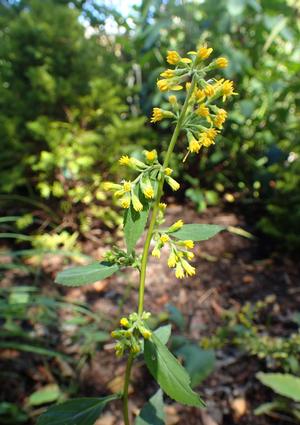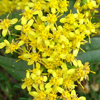

Plant Calculator
Enter the approximate length and width of the area you will be planting and click 'Calculate' to determine how many Solidago flexicaulis you will need.
Correct and successful spacing is complex and depends on project conditions. We encourage you to call us at 877-ECO-PLUG for project specific recommendations and further assistance.
Solidago flexicaulis
zigzag goldenrod (broadleaf goldenrod)
- Category: Perennial, Native
- Hardiness Zone: 3-8
- Height: 1-3 Feet
- Spread: 1-3 Feet
- Spacing: 12-18 Inches
- Bloom Color: Yellow
Solidago flexicaulis brings pollinators to your dappled shade areas with a subtle yellow flower clusters in mid-summer to fall. A hardy native perennial, it tolerates deer, shade, and clay soils.
Wetland Indicator Status
| • | Falcutative Upland (FACU) |
Plug Type
| • | Landscape Plug™ |
Propagation Type
| • | Open pollinated |
Additional Information about Solidago flexicaulis
Convincing gardeners to grow goldenrods is a bit like trying to sell Toyotas in Detroit, but I will continue anyway. They are certainly ubiquitous in the fall landscape and are still wrongly accused of causing hayfever. Therefore, it bears repeating that goldenrods, like aster, Joe-Pye, ironweeds, and all the Composites, are insect-pollinated, so their pollen is heavy and sticky in order to facilitate transfer by our six-legged friends. It is the wind-pollinated plants like grasses, ragweed and many trees (I am allergic to maples for example) that produce the great quantities of light, airborne pollen that get into our noses and throats and cause the immune reaction known as hayfever. There are goldenrods for every situation, and if you avoid the aggressively weedy species like S. canadensis (My apologies to Canada) and S. graminifolia, they are agreeable garden subjects at home in the border, meadow, rock, or shade garden. Once I started to learn the different species, I became more and more aware of their subtle differences and convinced of their important role in native ecosystems as soil stabilizers and sources of food and shelter for wildlife. They are beautiful in leaf and flower, too, and no wildflower garden is complete without a few of our hundred or so species scattered around. - William Cullina, The New England Wild Flower Society Guide to Growing and Propagating Wildflowers, p. 197
A great, compact pollinator plant for part shade conditions. Semi-evergreen basal leaves provide excellent erosion control.
Growing & Maintenance Tips for Solidago flexicaulis
An eastern North American native that is easy to grow in well-drained, average to moist soils. This woodland edge species does best in dappled sun, but also grows in full sun and full shade.

